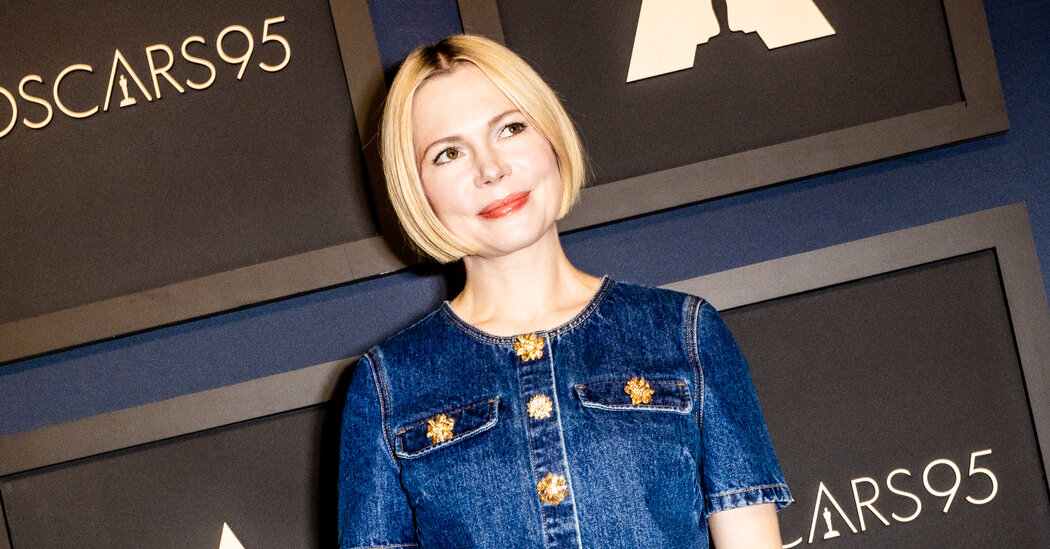
Snippets of Michelle Williams’s narration of Britney Spears’s new memoir have proved explosively popular online. But what goes into selecting a celebrity reader for an audiobook?
It’s not clear how many takes it took to get that “fo’ shiz, fo’ shiz” just right in the recording studio. But however many it was, the actress Michelle Williams landed on a line reading that has resonated on social media.
The quotation in question is part of her five-and-a-half-hour audiobook narration of Britney Spears’s best-selling new memoir, “The Woman in Me.” And while audiobook memoirs are traditionally voiced by the authors, in an introductory recording, Ms. Spears explains that because of the “heart-wrenching and emotional” subject matter, she would not be providing her own voice-over.
Instead, it’s Ms. Williams’s voice that listeners hear. Although her impression of Justin Timberlake encountering Ginuwine was widely circulated on X, formerly Twitter, there are passages in the book that are somber. Ms. Williams narrates how the pop singer had an abortion while she was dating Mr. Timberlake, started drinking alcohol with her mother at age 14 and how she navigated her 13-year conservatorship.
Simon & Schuster, which published “The Woman in Me,” did not immediately respond to questions about how Ms. Williams was selected to read Ms. Spears’s memoir. But in the world of audiobooks, the idea for many such pairings often comes from the producers.
“I like to think of my job as kind of matchmaking,” said Sara Jaffe, a senior executive producer at Penguin Random House.
Ms. Jaffe said she saw her job not as finding the most famous Hollywood name to narrate a book, but rather as casting someone who can help “connect the reader to the text.”
“I think actors who are also readers can really tap into the emotional vein that keeps any story humming along,” she said.
Sometimes, however, the suggestions flow in the other direction. Ms. Jaffe recently finished three days of production on Julianne Moore’s recording of “Day,” a new novel by the Pulitzer Prize-winning author Michael Cunningham. According to Ms. Jaffe, Ms. Moore — who starred in a film adaptation of Mr. Cunningham’s novel “The Hours” — reached out to Mr. Cunningham’s team through her agent to express interest in narrating the book.
Flexible actors who have a wide range and who understand the writing are also on the top of the casting checklist for Karen Dziekonski, vice president for production at Penguin Random House.
Ms. Dziekonski recently worked with Lucy Liu on the audiobook recording of “Our Missing Hearts” by Celeste Ng.
“We had heard from Lucy’s agents, probably in the fall of 2021, that Lucy was interested in narrating audiobooks,” Ms. Dziekonski said. (None of the producers interviewed for this article would discuss pay rates, which, they said, can depend on the length of the book and the prominence of the actor, among other factors.)
Ms. Dziekonski, who has been producing audiobooks since 2000, suggested her as narrator to Ms. Ng.
Ms. Liu was very easygoing, Ms. Dziekonski said: “I don’t think she had any particular ritual in the studio other than maybe, like, putting on lip gloss or something to keep her lips moist.”
Other A-list actors such as Meryl Streep, Reese Witherspoon and Willem Dafoe have gone on to give notable readings in audiobooks by performing with their voice.
“They aren’t reading, they are performing,” said Lisa Hintelmann, the head of casting and talent at Audible. “They want to be able to give an actual performance that is coming exclusively from their voice.”
According to Ms. Hintelmann, voice-over work gives actors an opportunity to “stretch a new creative muscle.” Because they are not performing a single character in a book, actors will often have to coax out subtle changes in their voice to portray different characters. Dialect coaches sometimes help with that aspect.
“Sometimes you’re female and you’re doing a male character,” Ms. Hintelmann said. “So you’re not going to try to actually sound like a man, but you’re going to maybe take it down a register to indicate it’s a different character and that it’s a male.”
The casting process also depends on the marketing of the book. In 2019, Ms. Hintelmann was looking to cast a young celebrity who could attract youthful listeners for the Audible narration of “The Baby-Sitters Club,” a Scholastic book series first published in 1986. She found the actress Elle Fanning, who was in her early 20s at the time, for the voice-over.
“This was an iconic series that, you know, a lot of us at Audible have grown up with and shared with our kids,” Ms. Hintelmann said. “We thought it would be fun to introduce it to a new generation.”
Voice-over work is typically a cozier form of acting, often involving only a voice coach, a sound engineer and the narrator.
“It’s extremely intimate, and that’s what you want to get out of a performance,” Ms. Hintelmann said. “You want the listener to really feel it.”
For most actors, it’s a far different experience from working on a large decorated set. There are no wardrobe changes; there is no sitting in a trailer for hours on end for hair and makeup. Instead, actors can come as they are into the studio, and they don’t have to worry about the physical aspects of acting.
“They are performing the piece so that when people are listening, they are in their ears,” Ms. Hintelmann said.
Ms. Dziekonski said she looked for actors who prepare for a narration job just as they would prepare for an onscreen role. “They know who the characters are, how they should sound with the subtext of the material and how that will work,” she said. “That’s how they deliver it.”
